Seeing your peace lily’s leaves droop can be worrisome. It’s like the plant is signaling that something isn’t right. This drooping points to watering problems most of the time, but there are other sneaky reasons too.
This guide will help you understand why your peace lily might be drooping. I’ll cover everything from getting too much or too little water, to stress from sunlight and pests. You’ll learn how to recognize the signs and what steps to take to help your plant thrive again.
Are you ready to become a plant detective? Let’s seee how to keep your peace lilies healthy and full of life.
- Related article: Guide to Growing Peace Lilies
7 Key Takeaways on Peace Lily Drooping Leaves
1. Overwatering your peace lily can suffocate its roots, leading to rot. This condition prevents the roots from absorbing oxygen, causing the plant to droop.
2. On the flip side, not watering enough makes the peace lily lose moisture, struggling to stay hydrated, which also results in drooping.
3. Peace lilies love indirect light. Too much direct sunlight stresses them out, causing wilting or drooping.
4. Pests like mealybugs suck the plant’s moisture, leading to dehydration. This makes the peace lily droop and shows damage on its leaves.
5. Sudden temperature changes from drafts or heaters can shock the peace lily, causing it to wilt.
6. The right soil is important. Soil that holds too much water or drains too quickly can lead to drooping.
7. Peace lilies thrive in humidity. If the air is too dry, their leaves can wilt, turn brown, or become crispy.
Reasons Why Your Peace Lily Is Drooping
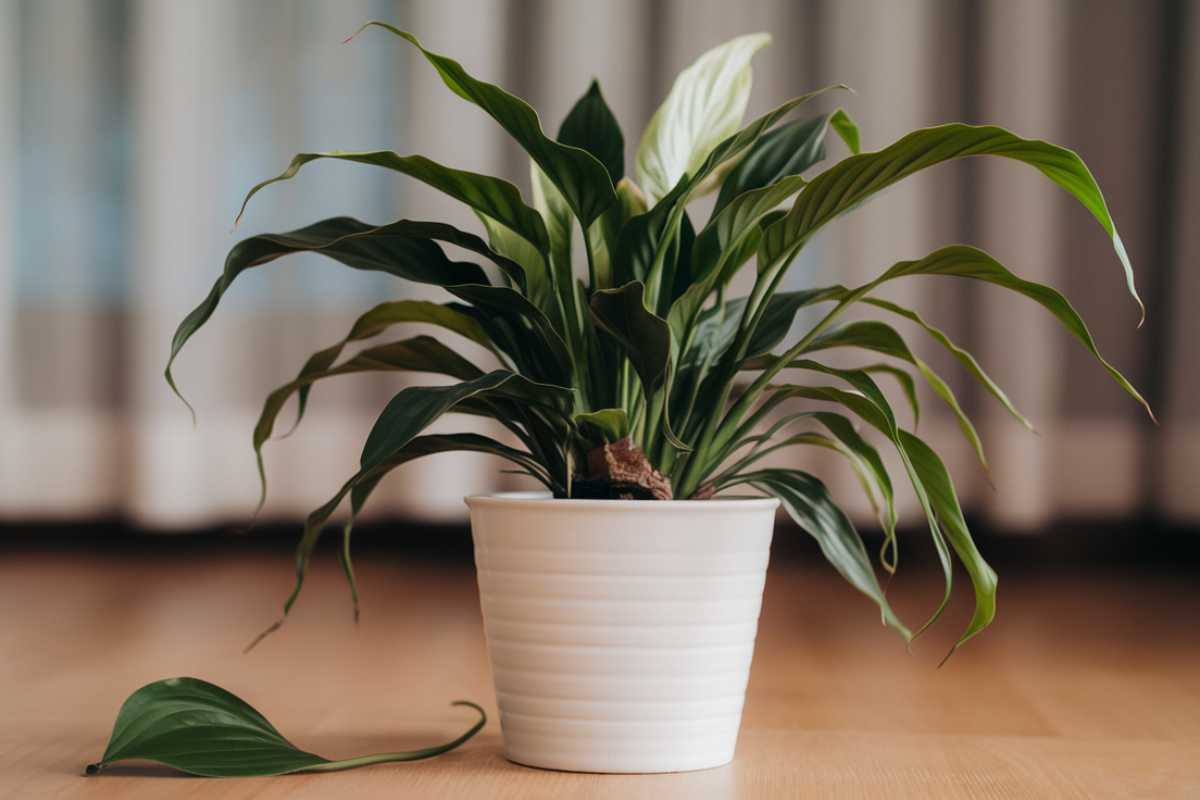
A drooping peace lily often gets me thinking about its causes, and guess what? The usual suspect is watering. But here’s the twist: both too little and too much water can cause this sad droop. It’s like the plant is caught in a watering tug-of-war. Yet, that’s not the whole story. Other culprits can include too much sunshine, pesky pests, or even plant diseases.
This mix of potential problems shows how important it is to play detective first. Figuring out what’s really bothering your peace lily helps you choose the right fix. That way, you stop any extra harm before it starts.
1. Underwatering

The lack of water will cause your plant to dry out and the foliage will begin to wilt. Droopy leaves are often the first sign that your plant needs a drink. Leaves will wilt because of a lack of moisture. Yellow leaves will be a clear indication of underwatering.
You can easily determine if underwatering is the culprit because the soil bed will be dried out. Seriously affected leaves that have changed color will require pruning. If the leaves are still green and just wilting, within a day of watering they should rebound and spring back to life.
2. Overwatering
When looking at a wilting plant, it may not cross your mind that overwatering can be the cause, but it can and does. When a plant is overwatered, there’ll be soggy and waterlogged soil, practically drowning the plant’s root system.
Roots need oxygen as much as they require water. When they are left to sit in excess water, they drown, because oxygen is unable to reach roots.
The roots cannot absorb nutrients vital to their survival when sitting in water or photosynthesizing, and the leaves begin to droop. This is usually a result of poor and inadequate drainage with the container.
Overwatering may also exhibit other symptoms together with drooping. These include black-tipped roots, brown leaf tips and edges, brown spots on stems, and lower, yellow leaves on the plant.
- Read more: Reasons Peace Lily Leaves Are Turning Yellow
Overwatering can open the door to diseases such as root rot, Phytophthora, Cylindrocladium, and Pythium.
In the case of overwatering, follow these steps:
- Repot your plant, preferably in a larger container.
- Remove the peace lily from soggy soil and discard the old soil.
- Allow the roots to dry.
- Repot your peace lily in fresh, well-draining soil.
Do not resume watering for a couple of days. When repotting, make sure that your pot has a sufficient number of drainage holes.
3. Too Much Sunlight
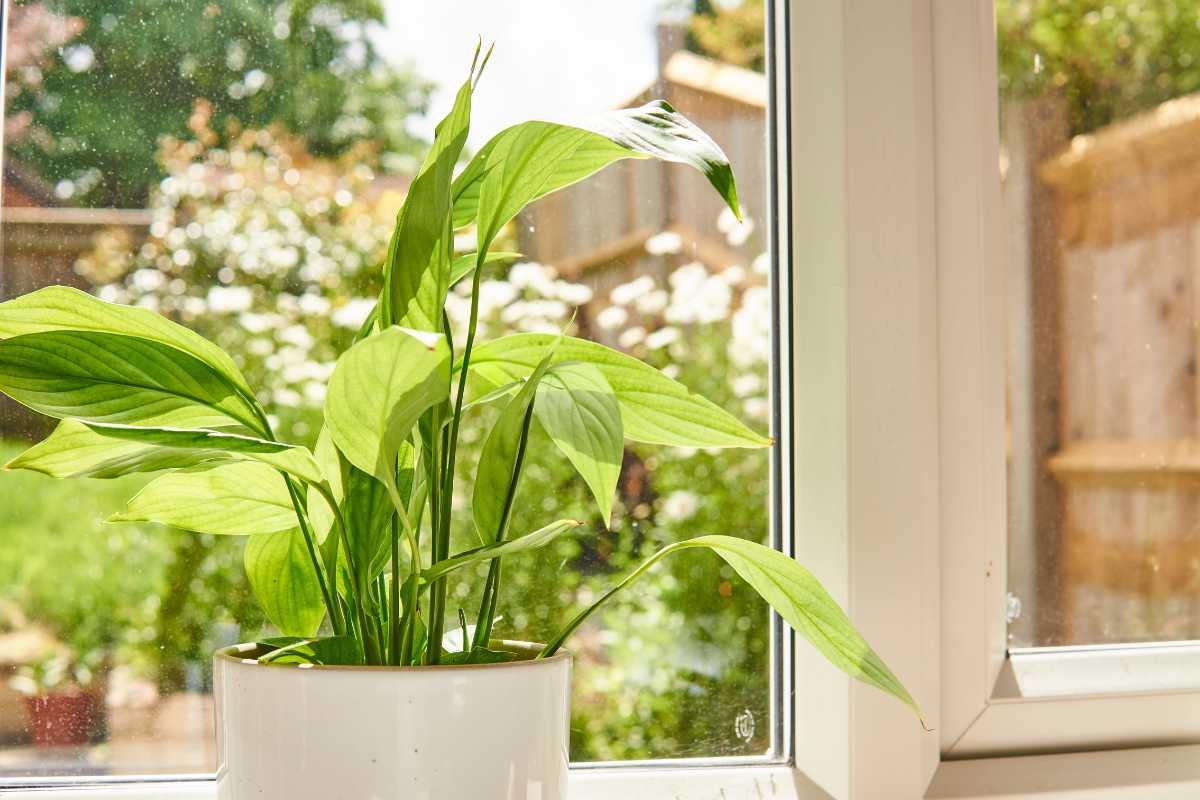
Peace lilies come from tropical rainforests. They grow low to the ground, getting light that filters through the trees, not direct sunlight. This is why peace lilies do well in medium to low light.
These plants are used to bright, indirect light. Too much direct sun makes their leaves droop because they lose moisture too fast.
To keep your peace lily happy, place it where it gets indirect light or some shade. If the leaves start to scorch, it’s getting too much direct sun.
If this happens, move your plant out of the direct sun. Trim any damaged leaves to keep the rest of the plant healthy.
4. Pest Infestations
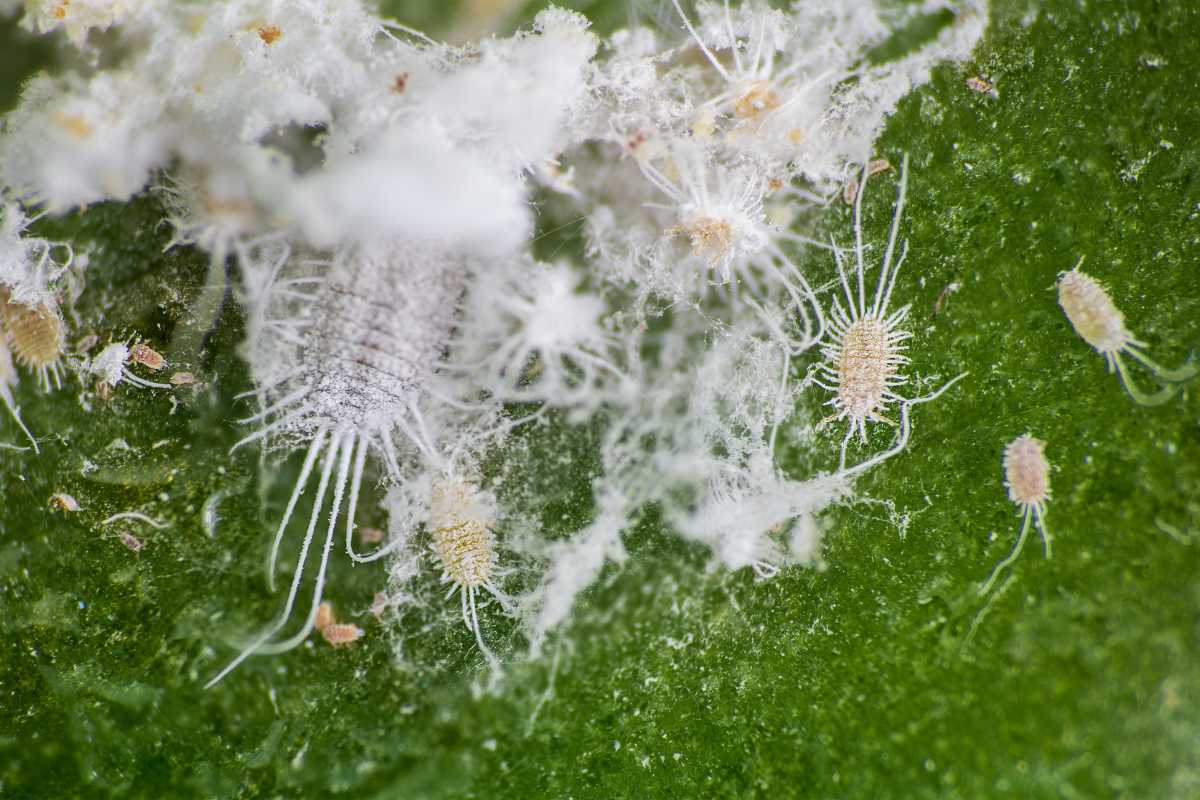
Peace lilies are not susceptible to all pests, but they are at risk for a few. Among problematic pests are mealybugs and spider mites. The presence of these pests should not be ignored because they can do extensive damage to peace lilies.
Mealybugs are sap-sucking bugs that especially like peace lilies. They attach themselves to the plant to suck the sap. The plant will begin to dehydrate, and the foliage will droop.
If your plant is drooping, examine it carefully. Look for fluffy white deposits on the stem that resemble small cotton balls. If they are present, your plant has a mealybug infestation. Because these insects live in colonies, your plant is unlikely to have only one.
To remove the mealybugs on your peace lily, follow these steps.
- Dip a cotton ball in alcohol and clean the plant, removing any insects.
- You can also spray your plant with a 70% solution of isopropyl alcohol, which is safe for your plant.
- Spray the entire plant thoroughly.
The following day, rinse your plant in the shower to remove dead insects. An alternative to alcohol is insecticidal soap. The plant should be sprayed completely with insecticidal soap to take care of the insect infestation.
5. Temperature Changes
Peace lilies love the warm, cozy spots of tropical rainforests. That’s why they do best indoors where it’s between 65° and 85°F. They can handle a little chill at night, dropping to 55°F, but that’s their limit.
If things get too hot or too cold for them, you’ll see their leaves start to droop, and they might even lose some. This is especially true if there’s a heater or air conditioner nearby, making the temperature swing too much.
To avoid temperature fluctuations:
- Keep your plant away from drafty windows, doors, and hallways.
- Never place your plant near a heating unit, an air conditioner, or vents.
- They should also not be placed near fireplaces in use.
Should your plant begin to droop, and you suspect temperature fluctuations as the cause, move your plant to an area subject to less potential temperature change. After several days, check your plant for improvements. If your plant is still drooping, look for another cause.
6. Poor Soil Conditions
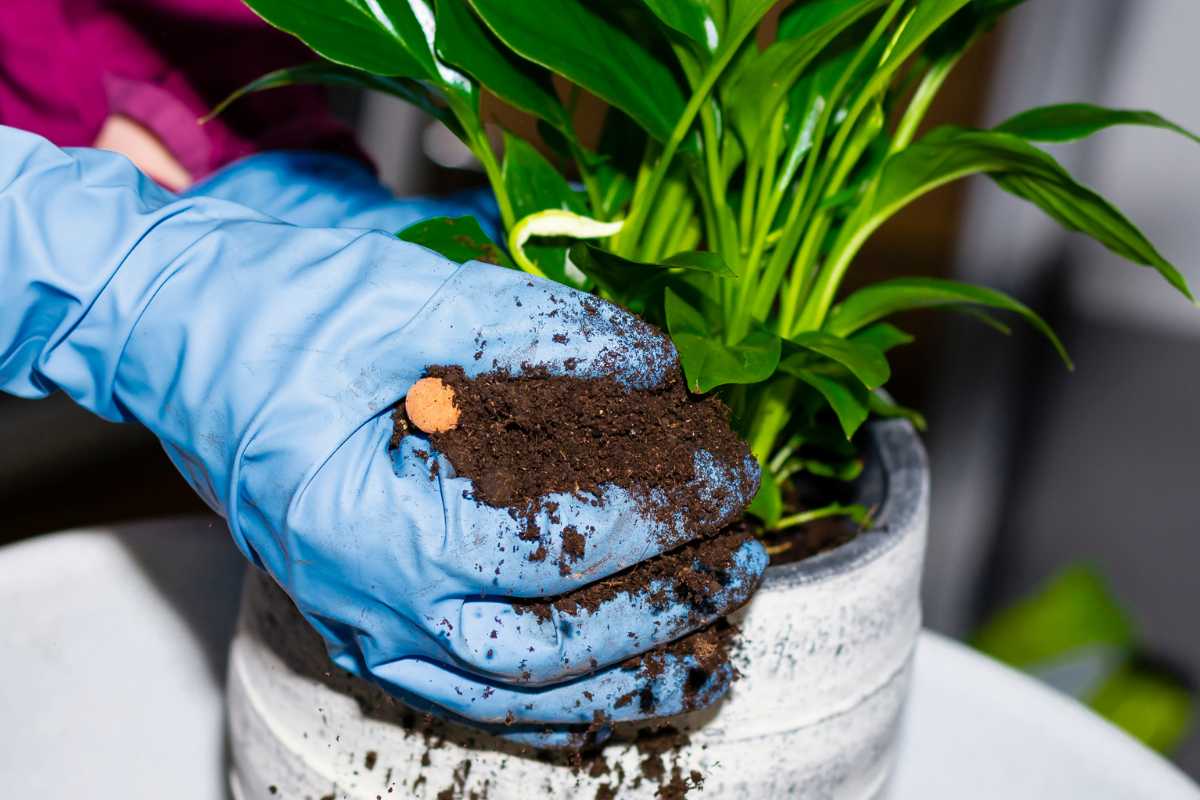
A standard quality potting soil should allow your peace lily to thrive. There are, however, soil conditions that can exert a negative influence.
If the soil is waterlogged, because it is overwatered or not draining properly, it will suffocate your plant’s root system and lead to root rot. The plant will not be able to receive sufficient oxygen or absorb sufficient nutrients.
Another soil problem is when the soil bed drains too rapidly. In this case, the plant will also not be able to absorb nutrients or sufficient water for survival.
When potting your peace lily, you want fresh soil and take care to AVOID these types of soil:
- Clay soil leads to waterlogging. Clay soil does not absorb and drain water easily or rapidly.
- Sandy soil will drain too rapidly, not permitting the plant to adequately absorb water or nutrients.
If you suspect the soil bed is the reason for a peace lily drooping, repot your plant in quality potting soil amended with perlite, bark chips, or peat moss.
7. Low Humidity Levels
My peace lily loves a humid environment. When the air is dry, its leaves start drooping, and I see other signs like brown edges, crispy spots, and yellowing leaves. If your peace lily is wilting and showing these signs, it’s probably not getting enough humidity.
- Learn more: Browning Peace Lily Leaves
But don’t worry, you can boost the humidity around your plant in several ways. Here are some tips that have worked for me:
- Use a plant humidifier in the area.
- Mist your plant several times a week.
- Group plants together to raise the surrounding humidity.
- Create a pebble tray and place your plant pot on top of it.
To create a pebble tray, fill a tray with pretty pebbles, stones, or rocks. Fill the tray with water then set your peace lily on top. The drainage holes of the container should not come into contact with the water in the tray. A tray will raise the humidity around the plant as the water evaporates.
8. Diseases
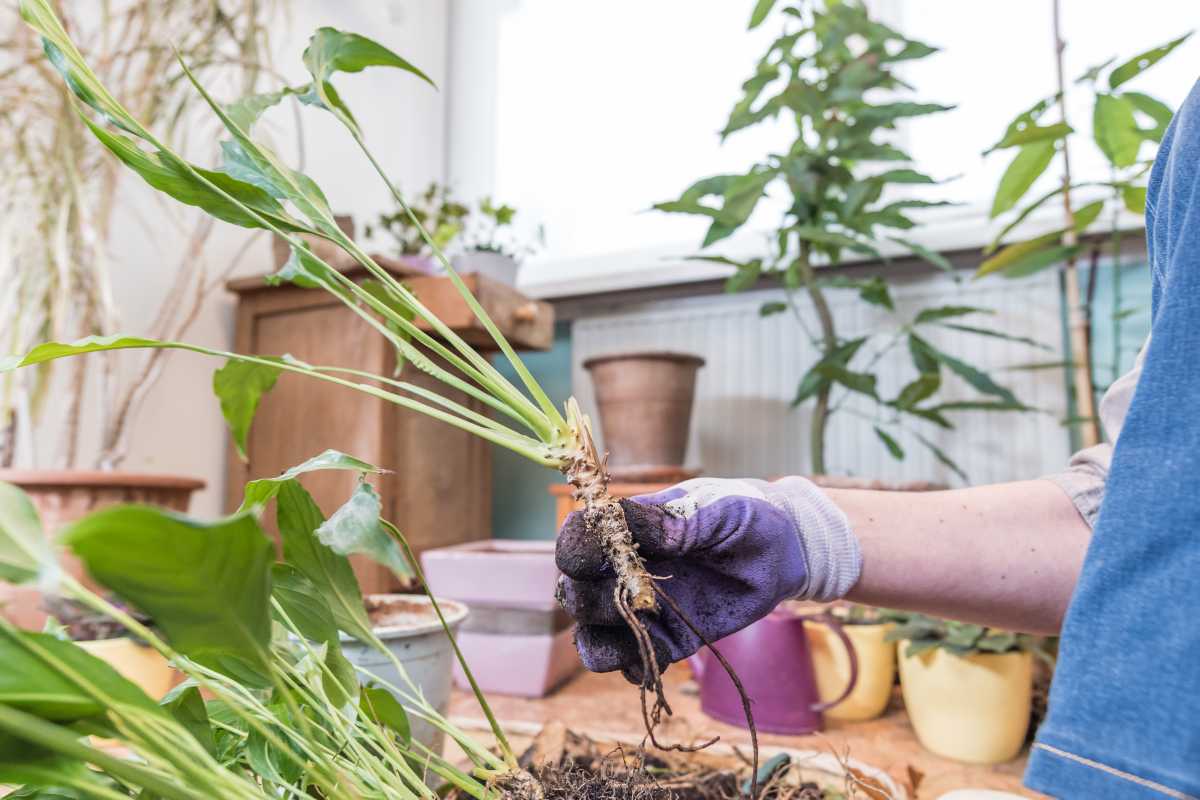
A peace lily is susceptible to Cylindrocladium or root rot. Leaves and stems will change color, and leaves will wilt. The roots will appear wet and mushy.
If this is the case, remove the plant from its pot. Remove all the old soil. Trim away damaged and affected roots. Dip the roots in a fungicide or spray them with one. Replant your peace lily in a new container with fresh potting soil.
Throw out the old soil, so it doesn’t contaminate other plants and grass. All gardening tools used and the old container need to be sterilized to remove any remaining fungal contaminants. This disease is usually brought on by overwatering.
Peace Lily Drooping Leaves Final Thoughts
Taking care of a peace lily is a fulfilling task. But when you notice its leaves drooping, it might be trying to tell you something’s not right. It’s important to find out why this is happening. It could be too much or too little water, not enough light, pests, or even the air around it.
To help your peace lily bounce back, look closely at it and make some changes to how you care for it. Each peace lily is different, so paying attention to what yours needs is really important. With the right care, your peace lily can stay healthy and beautiful, adding a lovely touch to your home for a long time.
Peace Lily Drooping Leaves FAQs
1. Why Are the White Blooms on My Peace Lily Turning Brown?
If your beloved plant, a peace lily, has white blooms turning brown, it might be due to aging or too much direct sunlight. Keep it in indirect light, water it consistently, and trim the brown blooms for new growth.
2. What Signs of Pests Should I Watch for on My Peace Lily?
If you notice yellow leaves, webbing, or sticky spots on your peace lily, pests might be the issue. Check your plant for mealybugs or spider mites often. Good drainage helps keep these pests away.
3. How Can a Lack of Proper Drainage Affect My Peace Lily?
To keep your peace lily healthy, make sure it has sufficient drainage A potting mix that drains well and a pot with enough holes stops water from sitting and causing problems like drooping leaves or root rot.
4. Can Nutrient Deficiency Cause My Peace Lily to Droop?
Yes, nutrient deficiency makes peace lilies droop and turn pale. To fix this, place your plant near a good light source and use balanced fertilizer now and then. This keeps your peace lily growing healthy and strong.
Read more about the peace lily plant and caring for it:




